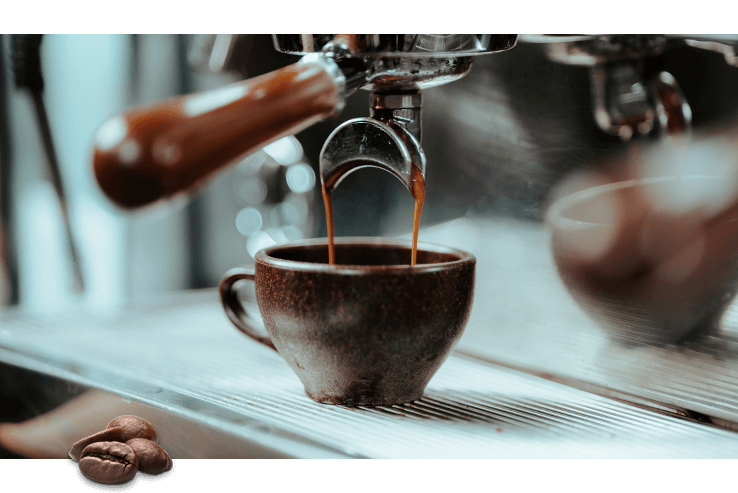Comprehending Coffee Beans: the Journey From Coffee to Blended Coffee Beans

The Origins of Coffee: A Global Viewpoint
While you may think of coffee as a modern staple, its origins trace back centuries, linking with societies throughout the world. The story begins in Ethiopia, where legend claims a goat herdsman named Kaldi discovered the energizing impacts of coffee beans after observing his goats romping energetically after consuming them.
As trade routes expanded, coffee made its way to Europe in the 17th century, rapidly obtaining appeal. Each culture included its unique twist to coffee prep work, enhancing its history.
Growing and Harvesting of Espresso Beans
As coffee's trip developed, the emphasis moved to the cultivation and harvesting of details bean ranges, specifically those used for espresso. You'll find that coffee beans frequently come from Arabica or Robusta plants, each offering distinct flavors. The ideal growing problems consist of high altitudes and rich, well-drained dirt, which improve the beans' quality.
Throughout the harvest, selecting methods differ. Timing is vital; you desire to harvest when the cherries get to peak perfection for maximum taste.
As soon as gathered, the beans are planned for handling, which is important in establishing their final taste. Understanding the farming and harvesting processes offers you understanding into what enters into your favorite espresso, improving your gratitude for every cup.
Processing Techniques: From Cherry to Bean
Since you've discovered harvesting espresso beans, allow's explore exactly how those cherries change into the coffee beans you enjoy. You'll see how different harvesting strategies effect taste, adhered to by the essential actions of fermentation and drying. Finally, we'll break down the milling and grading procedure that determines your coffee's high quality.
Gathering Methods Described
When it involves coffee, understanding harvesting strategies is important, given that they directly impact the taste and high quality of the beans you enjoy. There are two main methods: discerning picking and strip selecting. Discerning picking includes hand-picking only ripe cherries, ensuring you get the very best high quality beans. This approach frequently causes a richer taste account, though it's even more labor-intensive. On the other hand, strip picking ways harvesting all cherries simultaneously, no matter ripeness. While it's quicker and cheaper, this can result in a mix of tastes, influencing the end product. Eventually, the selection of collecting technique can greatly influence your coffee experience, so it's worth knowing just how those beans made it to your cup.
Fermentation and Drying Out
After harvesting, the next action in processing coffee beans play a significant function in shaping their taste. You'll locate that fermentation is vital, as it assists break down the mucilage surrounding the beans, improving their preference profile. Depending upon the technique, this process can last from a couple of hours to a number of days, with varying results based on temperature level and moisture.
Sun-drying allows the beans to soak up flavors from the setting, while mechanical drying out guarantees consistent wetness levels regardless of weather condition. Appropriate drying out is crucial to stop mold and mildew and maintain the beans' quality, ultimately affecting your mug of coffee.
Milling and Grading Refine
As fermentation and drying established the phase for flavor development, the milling and grading procedure guarantees that just the best coffee beans make it to your mug. This phase entails getting rid of the outer layers of the coffee cherry, consisting of the parchment and husk. After milling, the beans are sorted by size and weight, guaranteeing a consistent quality. You'll find that grading helps determine defects and categorize beans, which affects flavor and fragrance. Premium beans get a greater grade, resulting in a richer coffee experience. Once graded, the beans are prepared for product packaging and delivery, maintaining their unique attributes. This precise procedure is crucial for delivering the phenomenal preference you appreciate in every sip of your favored brew.
Roasting Techniques: Unlocking Flavor Potential
When you roast coffee beans, the approach you pick can significantly impact the flavor account. Comprehending the relationship in between time, temperature, and toasting methods is key to disclosing the potential of your mixture. Allow's explore just how these aspects come with each other to produce the best mug.
Roasting Methods Explained
While you might believe that all coffee roasting methods produce the very same outcomes, the reality is that each method discloses special taste capacities in the beans. You can choose in between methods like drum roasting, air roasting, or perhaps traditional frying pan roasting. Drum roasting uses a revolving drum to evenly disperse warm, boosting caramelization and producing a balanced flavor. Air roasting, on the other hand, circulates warm air around the beans, promoting a lighter roast with pronounced level of acidity. Frying pan toasting enables hands-on control yet requires continuous attention to stay clear of burning. Each approach has its nuances, so try out different methods can help you find the ideal roast that lines up with your preference preferences. Take pleasure in the journey of locating your suitable cup!

Effect On Taste Profile
Different roasting approaches not just affect the process however likewise substantially affect the taste account of the coffee beans. When you pick a light roast, you'll experience intense acidity and flower notes, showcasing the bean's origin. In contrast, a tool roast equilibriums level of acidity with sweetness, typically exposing chocolatey touches. Dark roasts, on the various other hand, highlight bold, great smoky flavors, in some cases covering up the bean's distinct features. Each method reveals various oils and compounds, leading to a large variety of tastes. By explore different roasting styles, you can find which accounts resonate with your taste buds. Understanding these subtleties helps you appreciate the creativity behind your cup of coffee, improving your total experience with every sip.
Time and Temperature Factors
To release the full flavor possibility of coffee beans, both time and temperature throughout the toasting procedure play significant roles. When roasting, you'll find that higher temperatures can rapidly establish flavors, yet if you rush it, you might finish up with burned notes. On the other hand, reduced temperatures permit a more steady taste growth, showcasing the beans' special attributes.

Timing is just as essential; extending the roast as well long can lead to a loss of acidity and brightness, while as well short a roast may leave the beans underdeveloped. Discovering that wonderful spot calls for technique and testing. By changing these aspects, you can expose the abundant, complicated flavors concealed within each bean, developing a genuinely remarkable coffee experience.
The Art of Mixing: Crafting Distinct Coffee Profiles

Beginning by selecting a base coffee that gives a strong structure. An intense Ethiopian bean can bring fruitiness, while an abundant Brazilian coffee includes body.
As you blend, bear in mind that each mix narrates. You're not simply making coffee; you're creating an experience. Take your time, preference frequently, and delight in the trip of uncovering your signature blend - Single Origin Espresso.
Developing Approaches: Just How Prep Work Influences Flavor
Blending coffee opens up a domain name of taste possibilities, but how you make that mix can significantly affect your final mug. Various developing methods extract unique tastes and scents, so it's critical to pick sensibly. For example, a French press allows sediments and oils to continue to be, producing an abundant, robust experience. On the other hand, a pour-over highlights the coffee's clearness and illumination, perfect for showcasing fragile notes.
Espresso, with its high stress, creates a focused shot that highlights sweet taste and crema. If you prefer a lighter mixture, take into consideration a cold brew technique; it generates a smooth, much less acidic taste.
Readjusting variables like water temperature, grind size, and brew time can change your coffee's profile. Embrace the art of developing to discover the tastes hidden in your coffee blends.
The Future of Coffee: Sustainability and Innovation
As the coffee industry evolves, sustainability and technology are ending up being important for addressing environmental obstacles and meeting consumer demands. You'll observe that even more check my reference coffee companies are embracing environment-friendly techniques, from sourcing beans ethically to executing sustainable farming methods. These changes not just help the planet but likewise enhance the top quality of the coffee you enjoy.
You might see innovations like eco-friendly packaging and water-saving developing approaches that reduce waste. Advanced innovation, such as blockchain, is likewise coming to be prominent, ensuring openness in the supply chain, which permits you to map your coffee back to its beginnings.
On top of that, spending in neighborhood neighborhoods and sustaining farmers via fair trade efforts fosters a more sustainable coffee ecosystem. As you sip your following mug, keep in mind that your options can add to a brighter future for coffee. By going with sustainable brand names, you're not simply appreciating a drink; you're making a positive effect on the globe.
Regularly Asked Concerns
What Is the Difference Between Arabica and Robusta Beans?
Arabica beans are smoother, sweeter, and have a greater acidity, while robusta beans are more powerful, extra bitter, and consist of more high levels of caffeine. You'll observe these differences in taste and scent when making your coffee.
Just How Does Altitude Affect Coffee Bean Taste?
Altitude influences coffee bean flavor substantially. Higher altitudes produce beans with brighter level of acidity and complicated tastes, while lower elevations frequently produce beans that are heavier and much less nuanced. You'll notice these distinctions in your cup!
What Are the Wellness Advantages of Alcohol Consumption Coffee?
Drinking coffee can improve your power, improve psychological emphasis, and even improve physical efficiency. It's rich in read the article antioxidants, might lower the danger of certain diseases, and can promote a much healthier metabolism when consumed in small amounts.
Can Coffee Beans Be Recycled for Brewing?
Yes, you can reuse coffee beans for brewing, yet the taste may be weak. If you appreciate experimenting, try recycling them in various ways, like cold brews or including in smoothies for an additional kick.
Just how Should I Shop Coffee Beans for Freshness?
To keep your coffee beans fresh, keep them in an impermeable container in a cool, dark place. Prevent subjecting them to warm, dampness, or light, as these variables can quickly degrade their flavor and aroma.
Comprehending Coffee Beans: the Journey From Coffee to Blended Coffee Beans.
Currently that you have actually discovered concerning collecting coffee beans, allow's explore how those cherries transform into the coffee beans you love.When you roast coffee beans, the method you choose can substantially influence the taste account - Single Origin Espresso.While go to this site you could assume that all coffee toasting techniques generate the exact same results, the reality is that each technique reveals unique flavor possibilities in the beans.Various toasting techniques not just affect the process but also significantly affect the flavor account of the coffee beans